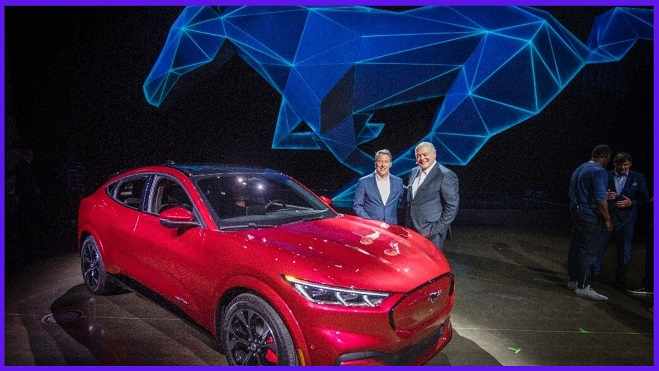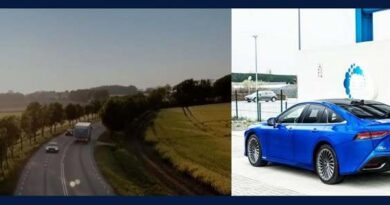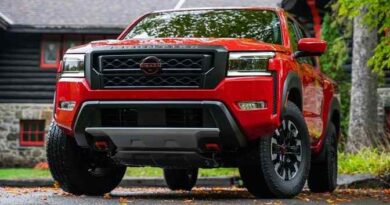Ford CEO Just Announced Plan To Destroy Tesla
Ford CEO Just Announced Plan To Destroy Tesla
Ford CEO Jim Farley recently announced one of the most insanely ambitious and ingenious plans for Ford to claim the golden crown of electric power transportation from current undisputed King Tesla.
This exciting news could potentially unearth a new, amazing era for EV fans like you and me. But why exactly is the inevitable clash between these two companies great news to you, the consumer, and more importantly, how could Ford possibly hope to take on an industry juggernaut like Tesla, something everybody else has failed to do and to beat them at their own game, no less?

To understand how Ford aims to wrestle Tesla into submission, we have to look at how exactly Tesla came to be regarded as by far the most successful manufacturer of electric cars the world witnessed.
It all started when multi-billionaire Elon Musk bought Tesla Motors to accelerate the advent of sustainable transport by introducing compelling mass-produced electric cars to market.
From the GetGo, Tesla took a unique approach to establish itself in the market, choosing not to attempt what everyone else was already doing, or at least trying to do, which is to build a relatively affordable electric car that’s easy to mass produce and market.
Opting instead to take the opposite approach, which is to focus on creating a compelling car that would create a demand for electric vehicles.
If we could have mass marketed our first product, we would have, but that was simply impossible to achieve for a startup company, Elon Musk stated.
no matter what it looked like and Our first product was going to be expensive. So we decided to build a sports car, as that seemed like it had the best chance of being competitive with its gasoline alternatives, he added.
And so Tesla delivered the first ever electric luxury sports car known as the Tesla Roadster, selling approximately 2500 units before ending production in early 2012.
Not exactly a number that would have General Motors giants quivering in fear at the time, but a decent start nonetheless.
Now comes the second stage of Tesla’s master plan. With its brand now established, Tesla’s business models quickly evolved far beyond the standard business models of fellow manufacturers by investing their newly acquired revenue into the ingenious approach of not simply selling to consumers, but additionally providing, servicing, and charging to all its products at an affordable cost to the average consumer.
What other electric car companies saw as a bad investment, a vulnerability with less exposure to buyers, tesla saw as an opportunity.
They used that opportunity to skyrocket the company’s success, transforming what was previously thought as a ludicrous idea into an industry standard, while helping it become the heavyweight we have today.
The final and most important piece of the puzzle of Tesla’s astounding success is the cunning utilization of yet another never before tried business tactic.
I don’t know about you, but I’m starting to see a pattern here, as the cars just sat there waiting for a potential buyer, they would have to be regularly maintained emerging money while adding extra cost to the product that ended up coming out of the buyer’s pockets.
Tesla chose to again go against established norms by leaning toward ignoring car dealerships and instead handling their businesses on their own by selling directly to the consumers.
Tesla’s business model wasn’t to focus on legacy automakers, as Elon Musk often talked about his desire for Tesla to cut as many costs as possible and pass that on to buyers, stating, we need to make stuff and make it efficiently.
Although Musk is referring to Tesla’s manufacturing process here, the same still applies to its selling process as well.
Minimum Marketing
minimum marketing and distribution costs being a key factor in his company’s unprecedented success.
How did Tesla all but slap dealership owners in the face to cut down on costs?
Well, almost all car manufacturers, electric or otherwise, chose to conduct their business through franchise dealerships at the time.
As you may or may not already know, dealerships mainly earn a profit through car sales, acting as a middleman, which, as we all know, translates into extra costs for the consumers more shed.
Further charges are added due to the cost of maintenance and inventory storage on the lot, emerging money as a result and leading to substantially higher expenses to the dealer, expenses which he elects to withdraw out of his buyer’s bank account.
Ditching the middleman meant Tesla’s products were now not only top quality and reliable, but also significantly cheaper than the competition, ultimately establishing a company-owned international network of galleries and showrooms electing to personally manage all its sales.
Tesla believes it can create a better buying experience, as, unlike most car dealerships, Tesla’s unique showroom sported no conflict of interest with potential consumers who stepped foot inside, one of them being greeted by Tesla’s very own trained sales staff.
That’s not saying cutting ties with dealership owners altogether didn’t present certain disadvantages, as Tesla certainly made some powerful enemies over the years by choosing to independently sell and distribute their product. As of May 25, 202.,
Tesla has over 800 locations around the world, also making use of Internet sales where customers can customize their very own Tesla vehicles before purchasing them online.
So now you know what Tesla’s biggest advantage is. Its ability to sell directly to consumers through its various showrooms and online websites, skipping the tedious process of having to go through car dealerships altogether, while cutting dealership-related costs down to a minimum and streamlining its delivery process to the customer.
Now, how exactly is the clashing of heads between these two megacorporations beneficial to you? Well, it’s quite simple. You see, competition among companies has always led to innovation, as warring companies battle and claw their way to win consumers’ trust.
The ensuing conflict ultimately brings forth products with better designs, more efficient consumption modules, and most importantly, much cheaper prices, all to the benefit of people like you and me.
So the real question is, what exactly is Ford’s plan of attack? For starters, Ford is taking a few pages from Tesla’s book, particularly regarding Tesla’s cheaper pricing.
Ford CEO Jim Farley disclosed his company’s plans to negotiate with car dealerships to cut selling costs by about $2,000, ensuring the company’s EVs remain competitive compared to Tesla and other EV makers.
Additionally, Ford is implementing a plethora of unique measures, such as direct selling low inventory models to consumers, helping to cut costs even further by about $600, or 700 per unit, according to Farley.
It seems Ford is going all in with this new business strategy. While it may not be ditching dealerships completely like Tesla did, which did result in Tesla falling through a legal hole it’s still struggling to get out of, ford still intends on strongarming car dealerships into playing by their rules by setting new requirements for dealers to sell EVs, such as including mandatory fast chargers and nonnegotiable pricing.
With this strategy, Ford is setting the foundation for a bright future in EV sales, not just in retail, but also online. So far, Ford does seem to be putting all their eggs into one beautifully handcrafted basket. And make no mistake, it’s paying off big time.
The American automaker currently sits at number two in the US. Sales trailing behind other than Tesla after truly embracing EVs in recent years, looks like Board is determined to go down this road.
it’s encouraging car dealers to have faith and go along with their plans. The General manager of two Ford dealerships in Michigan, Josh Sloane, stated the following we’re moving into this fast.
You’re not all in. You’re going to lose. The police-hungry EV enthusiasts already telling a grand slam on the scoresheet with the early success of its Ford F 150 Lightning.
You have to give it to Ford. Working with dealers rather than cutting them out is a smart move. For one thing, dealerships will naturally be incentivized to go along with Ford’s plan due to the massive growth in EV demand.
They wish to remain competitive with Tesla and other EV startups, and they do. More flexibility with price points is in order.
The automaker may be taking a page out of the Tesla playbook. Moreover, Ford is going to war with Tesla on all fronts, not just on the market, but on social media as well.
With Ford CEO calling out Tesla’s Elon Musk over Ford’s lead when it comes to electric pickup trucks, stating, Take that, Elon Musk, referring to, of course, Ford’s new electric pickup, the F 150 lighting, which has proven to be superior to Tesla’s cyber track on all fronts that truly matter.
Elon even fired back by jokingly saying, oh, do we have a little friendly competition in the electric pickup market?
Granted, the ford CEO did have great things to say about Tesla in the past, even praising Tesla in an internal meeting where he said no one does electricity better.
That still counts as a low blow in my book. And with Elon not being one to simply back out from a challenge, especially not one presented to him on social media.
As history has shown, you can expect Elon to hit even harder sometime in the following months, depending on what his company has in store and when it would be ready for a grand reveal.
Ford is not backing down from its showdown with Tesla. As the EV race heats up, expect the unexpected.
So there you have it, folks. It looks like the clash of biblical battery-powered proportions is in order.



